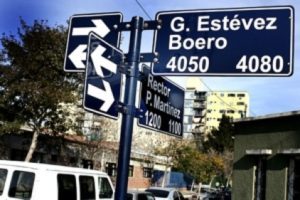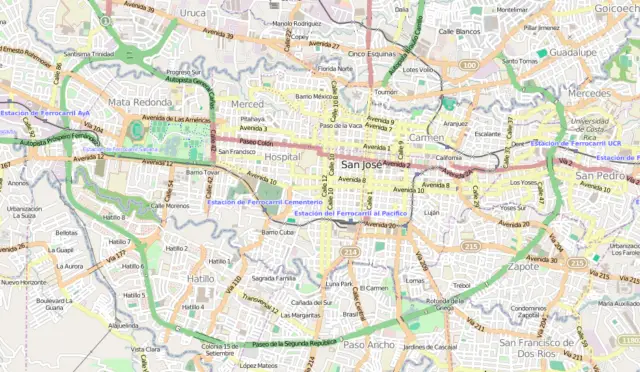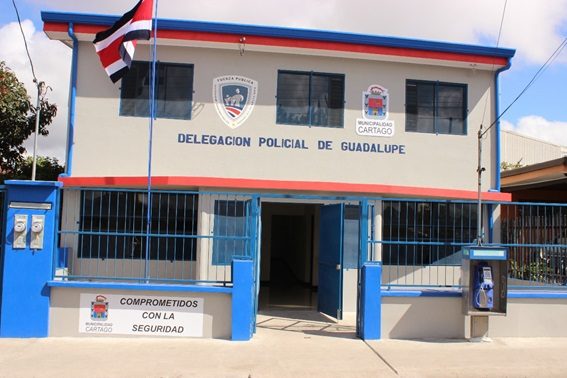
Costa Rica has a very peculiar way of indicating the addresses, since its streets do not have names or numbers and the houses do not have it either, next to an example of it:
My current address is 200 meters north of Pizza Hut, and then 400 meters west, but in a few months I will be able to give a street name and a number.
Thus, the Costa Rican media reported, in the words of the ex-mayor of San José de Costa Rica, about the attempt to change a custom that every time I have traveled to Costa Rica does not stop calling my attention: the fact that, as in the song of U2, the streets have no name.
The first time I noticed, was when one of my ex-partners of the tour company we had, we went to find licenses for the new offices in that country. Getting to the addresses we saw in the list that the real estate agent had sent us was impossible without someone living in the city, because not only had to know the things that were there and where they were, but also those that no longer existed.

As well? I tell you after this episode of 3 Travel Bloggers dedicated to the capital of Costa Rica in which, being injured of the leg and having to avoid moving a lot, for the first time I was able to travel to tranquility the city of San José, which is often overshadowed by the huge offer of overflowing nature that is the main attraction of this ecological paradise.
In this last trip to San Jose I could see that yes, they are now visible in many of the streets corner signs with their names but this is not something new: from “always” there has been a numerical system based on the original layout of the Costa Rican cities, but for some reason the Costa Ricans never got used to it and instead, when giving an address they refer to shops, restaurants, and even trees or anecdotes of popular characters supplemented by the number of blocks or meters that you have to travel to a certain cardinal point to reach the destination

Although this is absolutely normal in the country – and in fact when I have talked about it to some people, it is surprising that there is another way of locating in a city that is not that – for an outside visitor it can be a true nightmare. For example, as I read there, if we want to get to the Police Academy they will tell us that it is in front of the Castro Madriz School and if after that we ask them to tell us where that school is located, the answer will probably be “In front of the Police Academy”.
MAIN ENTRANCE OF POLICE ACADEMY
The most famous case is found in the San Pedro neighborhood of Montes de Oca where for decades the addresses were born and died from a famous “Higuerón”, (PICTURE AT THE BEGINNING OF THE ARTICLE) a sturdy tree that fell down after completing its life cycle. Well, it turns out that even without the famous fig tree, as a matter of habit, the reference remained the same, only with the adjective “old”. Therefore, any visitor to San Jose about 20 years ago that had to find a place with the “old fig” as the main coordinate, probably would be looking for it until now. Fortunately and to our relief, a “new fig tree” has been planted since then.
But that does not end there, one of the collaborators of the Holiday Inn Escazu hotel, where we stayed in San Jose, Costa Rica, told me that he was familiar with addresses that included small and fascinating stories of the type “… like three hundred meters west 2 houses before where the dog is tied “or, the most amazing of all,” from where the lady who always sells fruit, 100 meters to the north”.

SD on March 18, 2016, at 1:39 pm (ANECDOTE)
Good afternoon, an article with which I really felt identified since the address of the house in which I lived until I married takes as reference the Higuerón de San Pedro. As I see that he likes the anecdotes, and so that he makes a small correction, the Higuerón de San Pedro was not cut, he fell. I was very small but I will say that in 1991 because I have heard stories that say that it was in the wake of the Limón earthquake (7.7 Mw) that year, that the roots lost their grip and shortly afterward they fell to the ground. It was quite an event because it was a pretty impressive tree to be in a place where the concrete had already appropriated the landscape. Together with the tree, the power line collapsed, which caused several hours without electricity to the neighborhoods, including the one where I grew up. People came to see that majestic tree on the ground in the middle of the night, and many even took their time to cut some branches and carry a memory of that point of reference.
According to the Ticos, they told us, during the 40s, the Costa Rican people systematically opposed the name and number of their houses, showing a defiant attitude to progress, and that’s how it was until today: in a populous capital of Latin American, one still feels the warmth of the small towns of yesteryear.
